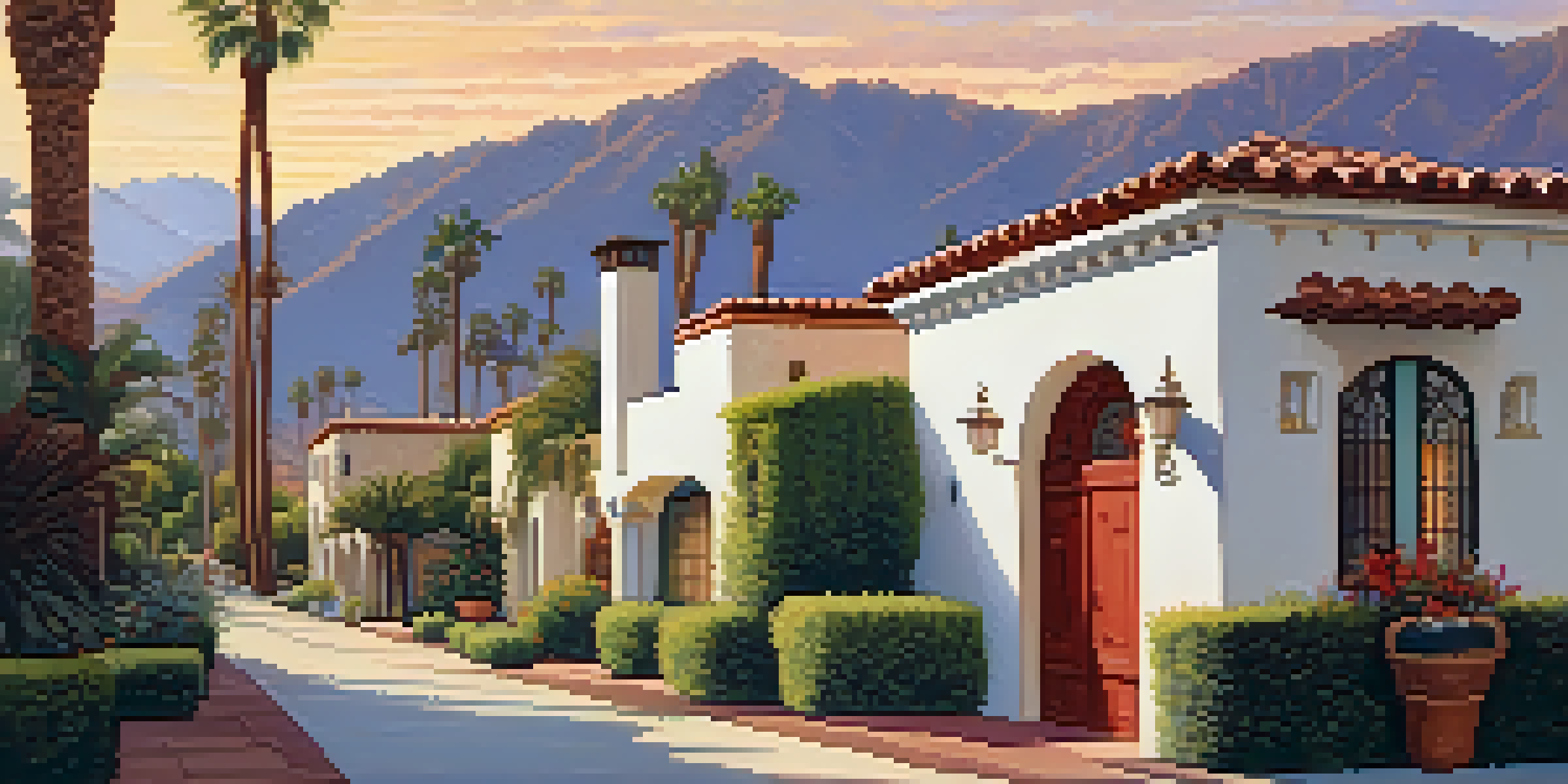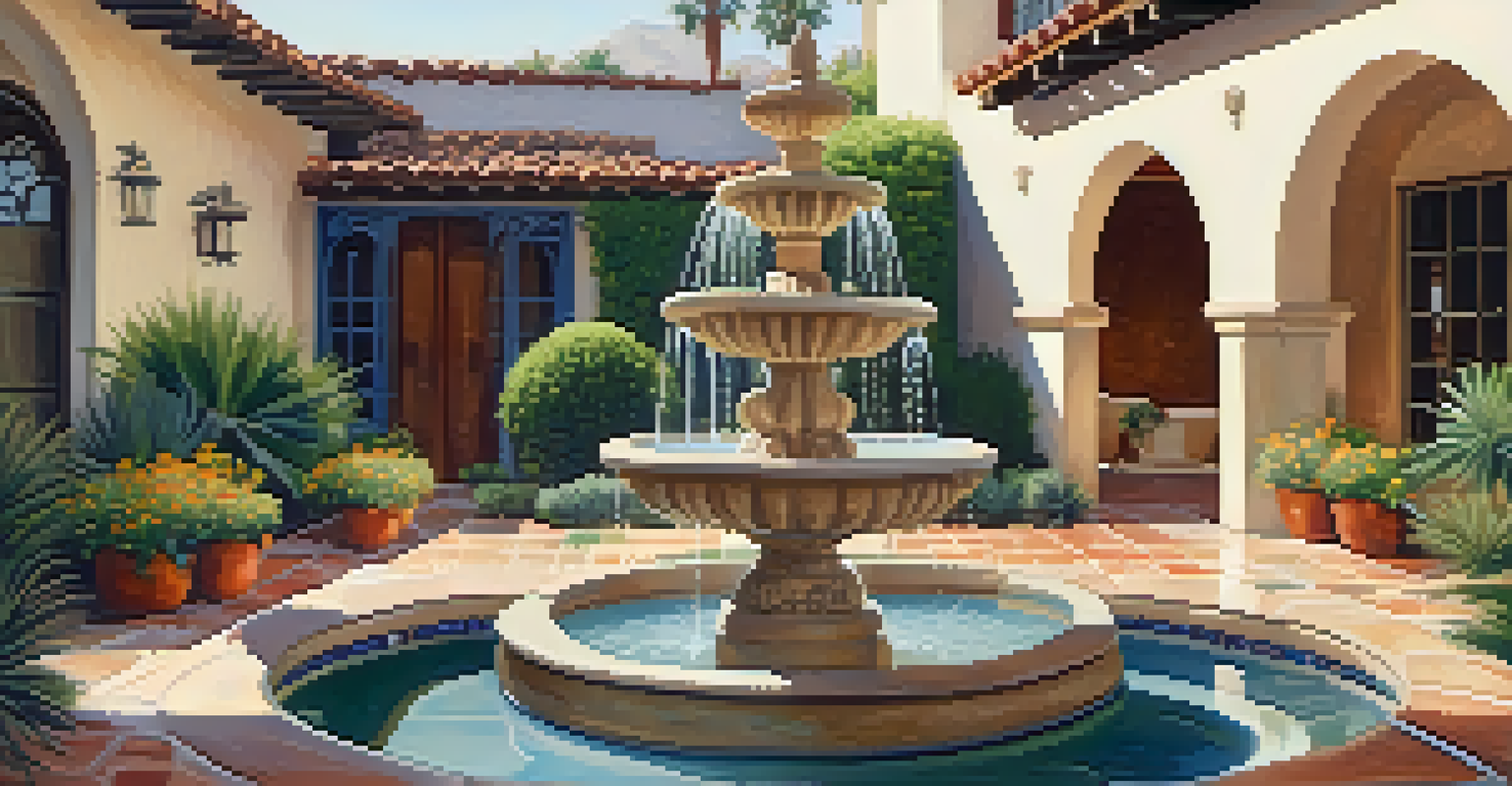Exploring Spanish Revival Architecture in Palm Springs

A Brief History of Spanish Revival Architecture
Spanish Revival architecture emerged in the early 20th century as a nostalgic nod to the colonial past of California. It draws inspiration from the Mediterranean styles, particularly from Spain and Mexico, characterized by stucco walls, red tile roofs, and intricate wrought iron details. This architectural style flourished during the 1920s and 1930s, coinciding with the rise of the Southern California lifestyle and its appeal to affluent residents and celebrities seeking a retreat.
Architecture should speak of its time and place, but yearn for timelessness.
In Palm Springs, the Spanish Revival style became a defining element of the city’s aesthetics, especially as it became a popular getaway for Hollywood stars. The architecture’s warm, inviting designs perfectly complemented the region’s desert landscape, creating a harmonious blend of indoor and outdoor living. The unique charm of Spanish Revival homes has captivated both visitors and residents alike, making it a staple in the area’s architectural heritage.
Today, many of these structures are preserved and celebrated, showcasing the craftsmanship and beauty of this style. Walking through the streets of Palm Springs, you can see how the Spanish Revival remains a beloved part of the city's identity, reflecting its rich cultural history and artistic influences.
Key Features of Spanish Revival Architecture
When you think of Spanish Revival architecture, certain features instantly come to mind. These include the use of white or beige stucco, red clay tiles, arched doorways, and colorful ceramic tiles that add a vibrant touch. The buildings often incorporate decorative elements like wrought iron balconies, wooden beams, and intricate tile work, creating a sense of warmth and charm that draws you in.

Additionally, the layout of Spanish Revival homes often emphasizes open spaces and courtyards, perfect for enjoying the sunny Palm Springs climate. These outdoor areas serve as extensions of the living space, allowing residents to connect with nature while enjoying their privacy. It's not unusual to find lush gardens or fountains that enhance the tranquility of these settings.
Spanish Revival's Rich Heritage
Spanish Revival architecture in Palm Springs reflects a unique blend of cultural influences and a nostalgic nod to California's colonial past.
These architectural elements work together to create a style that is both elegant and relaxed, perfectly suited for the lifestyle in Palm Springs. Whether you're admiring a grand estate or a cozy bungalow, the beauty of Spanish Revival architecture is evident in every detail.
Notable Examples of Spanish Revival in Palm Springs
Palm Springs boasts numerous stunning examples of Spanish Revival architecture that tell the story of the city’s past. One prominent example is the historic La Plaza, which features a charming mix of retail and dining spaces housed in beautifully designed buildings. As you stroll through, you can appreciate the details that reflect the city’s architectural heritage.
The past is never dead. It's not even past.
Another iconic structure is the Villa Royale Inn, a boutique hotel that captures the essence of Spanish Revival style. With its colorful tiles, arched windows, and serene courtyard, it offers a picturesque retreat for visitors. The inn perfectly encapsulates the allure of this architectural tradition, attracting those who wish to experience the charm of Palm Springs.
Lastly, the Kaufmann Desert House, designed by Richard Neutra, is a modernist take on Spanish Revival principles. While it incorporates contemporary elements, the spirit of the style is preserved in its use of natural materials and integration with the landscape, showcasing how Spanish Revival continues to inspire new architectural works.
Cultural Significance of Spanish Revival Style
The cultural significance of Spanish Revival architecture in Palm Springs cannot be overstated. This style reflects the blending of different cultural influences that define the region, from Native American heritage to Spanish colonialism. As a result, it serves as a visual reminder of the diverse history that has shaped Palm Springs over the years.
Moreover, the architecture has played a crucial role in attracting tourism, as visitors flock to admire the unique designs and historical importance of these buildings. The allure of Spanish Revival homes contributes to the city's reputation as a glamorous getaway, drawing in celebrities and architecture enthusiasts alike. The preservation of these structures is vital for maintaining the city’s character and charm.
Key Features Define the Style
The style is characterized by stucco walls, red tile roofs, arched doorways, and vibrant ceramic tiles that create a charming and inviting atmosphere.
As the community continues to embrace and celebrate this architectural style, it fosters a sense of pride and identity among residents. The enduring popularity of Spanish Revival architecture highlights the importance of cultural heritage in shaping the place we call home.
Exploring Spanish Revival Neighborhoods
To truly appreciate the beauty of Spanish Revival architecture, a stroll through Palm Springs’ historic neighborhoods is a must. Areas like the Movie Colony and Old Las Palmas are known for their stunning homes and lush landscaping, showcasing the best of this architectural style. Wandering through these neighborhoods feels like stepping back in time, where every corner reveals a hidden gem.
As you explore, you’ll encounter beautifully maintained properties with unique architectural details, such as colorful tiles and intricate wrought iron work. The vibrant gardens and outdoor spaces invite you to imagine the lives of those who once inhabited these charming homes. It’s an experience that connects you to the city’s history and the stories that these buildings tell.
Don’t forget to bring your camera—every turn offers an opportunity for a perfect shot of the enchanting architecture. Whether you’re a local or a visitor, taking the time to explore these neighborhoods is a rewarding way to engage with Palm Springs’ rich cultural tapestry.
The Future of Spanish Revival Architecture
As Palm Springs continues to grow and evolve, the future of Spanish Revival architecture remains a topic of interest. Many advocates are passionate about preserving the city’s architectural heritage, ensuring that new developments respect and reflect the original style. This commitment to preservation not only honors the past but also enhances the city’s unique character.
However, balancing modernization with preservation can be challenging. Developers and architects are increasingly looking for ways to incorporate contemporary design elements while maintaining the charm of Spanish Revival. This fusion of old and new can be seen in recent projects that blend traditional materials with innovative layouts, creating spaces that feel fresh yet familiar.
Preservation Meets Modernization
As the city evolves, efforts to preserve Spanish Revival architecture continue, balancing historical charm with contemporary design elements.
Ultimately, the ongoing appreciation for Spanish Revival architecture suggests that it will remain a beloved part of Palm Springs' identity. By embracing both preservation and innovation, the city can honor its rich history while adapting to the needs of future generations.
Visiting Palm Springs for Architectural Inspiration
If you’re an architecture enthusiast or simply curious about the beauty of Spanish Revival style, Palm Springs is the perfect destination. The city offers various self-guided walking tours that highlight its architectural treasures, allowing you to soak in the sights at your own pace. These tours provide insights into the history and significance of the buildings, making your exploration even more enriching.
Additionally, Palm Springs hosts events like Modernism Week, which celebrates mid-century architecture and design, including Spanish Revival influences. During this annual event, you can participate in tours, lectures, and exhibitions that delve into the city's architectural landscape, offering a unique opportunity to learn from experts in the field.

Whether you’re wandering through neighborhoods or attending special events, Palm Springs is a haven for those seeking inspiration in architecture. The captivating charm of Spanish Revival homes is sure to leave a lasting impression, inviting you to return time and again.